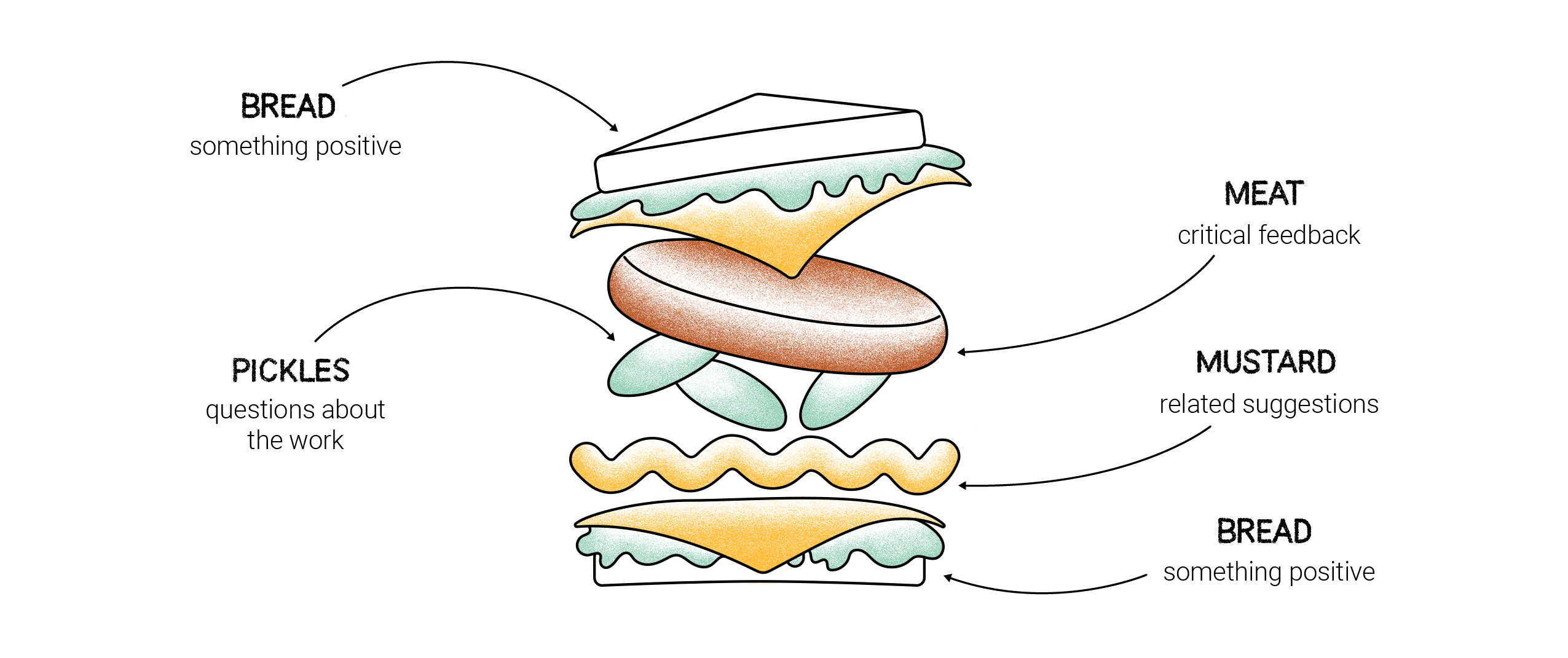Critique Sandwich on Compliment Bread

This activity is a K-12 variation on artist crits, in which artists receive critical feedback from peers.
Learnings include how to refine opinions, communicate positively and constructively, and take responsibility for oneself while hearing feedback. It also shows everything is a process and we all have room to grow!
Set the Stage
Since every student will present and receive feedback, consider creating a community agreement or revisiting a current one. Also, consider:
- Have the group commit to sharing feedback with good intentions; before speaking, students can ask themselves if their goal for sharing is to help their peers rather than criticize them or tell them what to do.
- Encourage students to focus opinions on the work more than centering feedback around the Maker.
- Discuss how when Makers receive opinions about their work it's best for them to assume their peers were well-meaning, even if peer feedback is imperfect and they hear something they don’t like or disagree with.
- If at any point the community agreement is violated, teachers can set up a restorative circle.
The Critique Process
ROOM SETUP (optional)
To inspire a different style of participation, consider shifting the room configuration to feel more communal or performative: you could push desks to the edge of the room and sit in a circle – OR! – arrange chairs in rows facing a “stage” created with tape on the floor.
STEP ONE: PRESENTATION OF WORK
Maker presents their work, which can be artwork, a story, video, poem, essay, etc. They describe what they want to achieve with the work and/or what they want ideas about–e.g. "I want it to make people stop and think" or "I want the painting to look more realistic."
STEP TWO: SHARING AND RECEIVING FEEDBACK
“Responder” students ask if they can share their opinions–the next page offers up a tool for how to structure and present opinions in a way that helps well-meaning feedback be well-received. The Maker has the option to say yes or no to receiving feedback; this requires the Maker to understand how open they are to opportunities to grow.
Sandwich-ing Feedback
Layering critical feedback with compliments makes it more appetizing and is especially helpful when students don't "get" or dislike their peer’s work.

At a minimum, it is recommended that students use a Bread < Meat > Bread approach to sharing their feedback; the Pickles and Mustard are bonus ingredients. Here is a bit more information about each layer:
BREAD: something positive
Before sharing, this approach asks Responders to identify something that is positive or striking about the work. Even if Responders dislike the work, they must find something meaningful to say; this approach rules out broad compliments like, “It’s good” and forces students to say something more specific like, “The color magenta you chose is beautiful.”
MEAT: critical feedback
Offer up things the Responder thinks could use improvement or refinement. Important: the feedback must relate to the Maker’s questions or areas of inquiry about their own work.
BREAD: Something positive
The idea here is for Responders to finish their feedback with another complimentary thought; it is fine to repeat what was said for the first “slice of bread" or to offer a new compliment.
EXTRAS:
“Pickles” can be questions about the work itself or things that the work made Responders curious about, e.g. "It made me wonder ..."
“Mustard” can be suggestions that relate to the Responders questions brought up previously; it's good to present these as possibilities rather than as facts–i.e. more "you could..." than "you should..."
Research Presentation EXAMPLE, including Pickles & Mustard
Bread: “I like the historical figure you chose.”
Meat: “You said a lot about their childhood; I’d like to hear more about their career.”
Pickles: “Have you researched any of their critics?”
Mustard: “Maybe talking about the critics is one way to give more career details.
Bread: “All together though, I think it’s a really good subject and want to know more!”